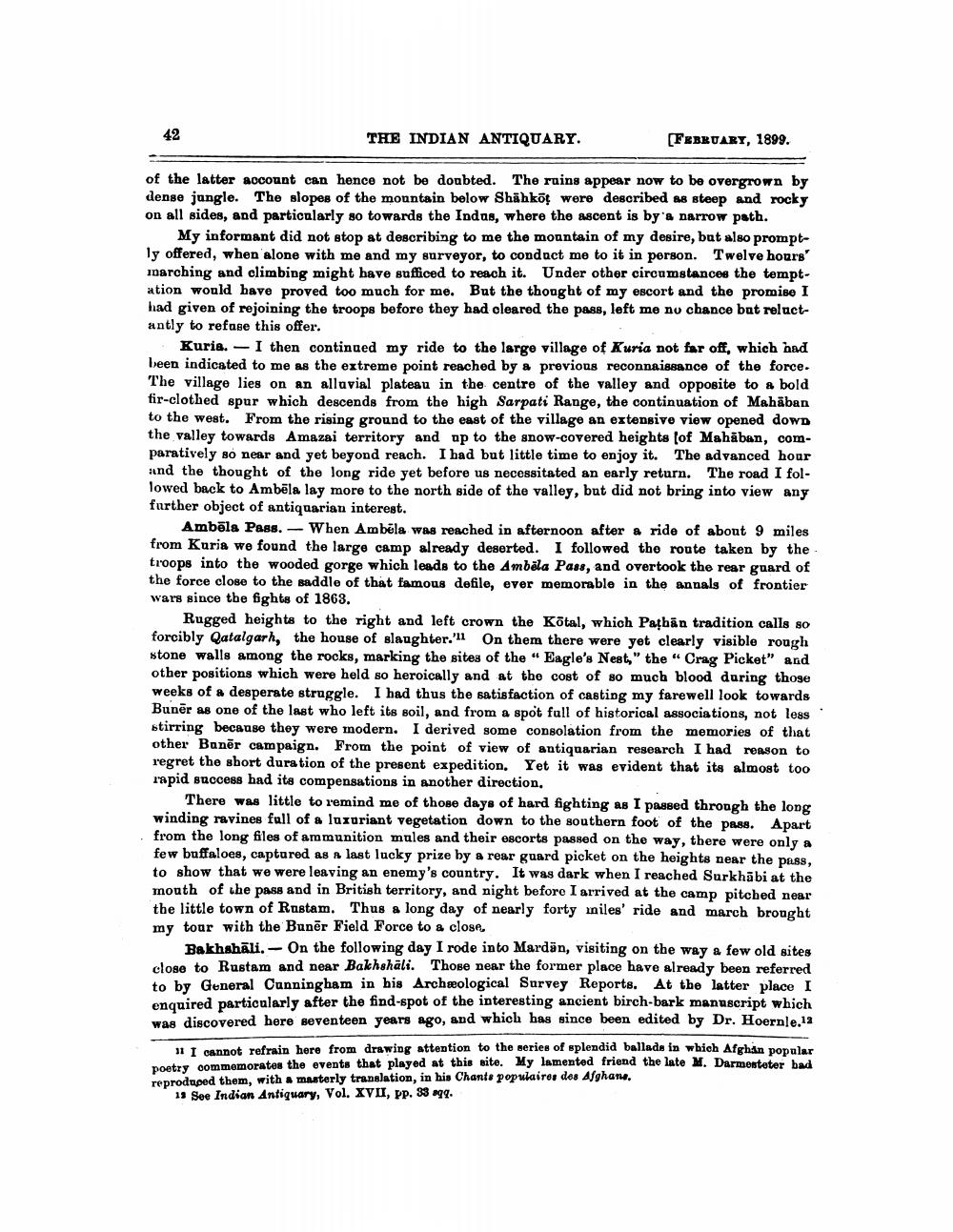________________
42
THE INDIAN ANTIQUARY.
of the latter account can hence not be doubted. The ruins appear now to be overgrown by dense jungle. The slopes of the mountain below Shahkōt were described as steep and rocky on all sides, and particularly so towards the Indus, where the ascent is by a narrow path.
[FEBRUARY, 1899.
My informant did not stop at describing to me the mountain of my desire, but also promptly offered, when alone with me and my surveyor, to conduct me to it in person. Twelve hours' marching and climbing might have sufficed to reach it. Under other circumstances the temptation would have proved too much for me. But the thought of my escort and the promise I had given of rejoining the troops before they had cleared the pass, left me no chance but reluctantly to refuse this offer.
Kuria. I then continued my ride to the large village of Kuria not far off, which had been indicated to me as the extreme point reached by a previous reconnaissance of the force. The village lies on an alluvial plateau in the centre of the valley and opposite to a bold fir-clothed spur which descends from the high Sarpati Range, the continuation of Mahaban to the west. From the rising ground to the east of the village an extensive view opened down the valley towards Amazai territory and up to the snow-covered heights [of Mahaban, comparatively so near and yet beyond reach. I had but little time to enjoy it. The advanced hour and the thought of the long ride yet before us necessitated an early return. The road I followed back to Ambela lay more to the north side of the valley, but did not bring into view any further object of antiquarian interest.
Ambōla Pass. When Ambela was reached in afternoon after a ride of about 9 miles from Kuria we found the large camp already deserted. I followed the route taken by the troops into the wooded gorge which leads to the Ambela Pass, and overtook the rear guard of the force close to the saddle of that famous defile, ever memorable in the annals of frontier wars since the fights of 1863.
Rugged heights to the right and left crown the Kōtal, which Pathan tradition calls so forcibly Qatalgarh, the house of slaughter.' On them there were yet clearly visible rough stone walls among the rocks, marking the sites of the "Eagle's Nest," the "Crag Picket" and other positions which were held so heroically and at the cost of so much blood during those weeks of a desperate struggle. I had thus the satisfaction of casting my farewell look towards Buner as one of the last who left its soil, and from a spot full of historical associations, not less stirring because they were modern. I derived some consolation from the memories of that other Baner campaign. From the point of view of antiquarian research I had reason to regret the short duration of the present expedition. Yet it was evident that its almost too rapid success had its compensations in another direction.
There was little to remind me of those days of hard fighting as I passed through the long winding ravines full of a luxuriant vegetation down to the southern foot of the pass. Apart from the long files of ammunition mules and their escorts passed on the way, there were only a few buffaloes, captured as a last lucky prize by a rear guard picket on the heights near the pass, to show that we were leaving an enemy's country. It was dark when I reached Surkhabi at the mouth of the pass and in British territory, and night before I arrived at the camp pitched near the little town of Rustam. Thus a long day of nearly forty miles' ride and march brought my tour with the Buner Field Force to a close,
Bakhshali. On the following day I rode into Mardän, visiting on the way a few old sites. close to Rustam and near Bakhshali. Those near the former place have already been referred to by General Cunningham in his Archeological Survey Reports. At the latter place I enquired particularly after the find-spot of the interesting ancient birch-bark manuscript which was discovered here seventeen years ago, and which has since been edited by Dr. Hoernle.12
11 I cannot refrain here from drawing attention to the series of splendid ballads in which Afghan popular poetry commemorates the events that played at this site. My lamented friend the late M. Darmesteter had reproduced them, with a masterly translation, in his Chants populaires des Afghans.
13 See Indian Antiquary, Vol. XVII, pp. 33 sqq.




